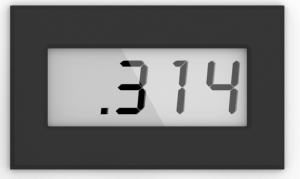Difference between revisions of "Panel Meter"
From TheAnalogThing
| Line 1: | Line 1: | ||
[[File:Voltmeter.png|thumb|Illustration of the display, showing the value <code>0.314</code>]] | [[File:Voltmeter.png|thumb|Illustration of the display, showing the value <code>0.314</code>]] | ||
| − | + | The '''panel meter''' is the LCD display unit located in the lower right on the upper PCB. | |
== Usage == | == Usage == | ||
| − | The panel meter | + | The '''panel meter''' is used in two different modes, depending on the position of the <code>MODE SELECTOR</code> knob: |
| − | * | + | * With the <code>MODE SELECTOR</code> knob in the <code>COEFF</code>, <code>MINION</code>, <code>IC</code>, <code>OP</code> or <code>HALT</code> positions, the panel meter displays the numerical value patched into the <code>u</code> socket in the <code>OUTPUT JACKS</code> section in the unit range -1 to 1. This allows monitoring any value in a program by connecting any socket on the patch panel with the <code>u</code> socket. In particular, it allows setting the values of coefficient potentiometers by connecting any potentiometer's output to the <code>u</code> socket and turning the respective potentiometer knob until the panel meter displays the desired value. |
| − | * | + | * With the <code>MODE SELECTOR</code> knob in the <code>REP</code> or <code>REPF</code> positions, the current <code>OP TIME</code> value is shown. It can be changed using the OP-TIME potentiometer. In <code>REP</code> (repeat) mode, <code>OP TIME</code> values are shown in the 0 to 10 second range. In <code>REPF</code> (repeat fast) mode, <code>OP TIME</code> values are shown in the 0 to 100 millisecond range. |
| − | |||
| − | |||
| − | |||
| − | |||
| − | |||
| − | |||
[[Category:Components of The Analog Thing]] | [[Category:Components of The Analog Thing]] | ||
Revision as of 05:53, 30 August 2021
The panel meter is the LCD display unit located in the lower right on the upper PCB.
Usage
The panel meter is used in two different modes, depending on the position of the MODE SELECTOR knob:
- With the
MODE SELECTORknob in theCOEFF,MINION,IC,OPorHALTpositions, the panel meter displays the numerical value patched into theusocket in theOUTPUT JACKSsection in the unit range -1 to 1. This allows monitoring any value in a program by connecting any socket on the patch panel with theusocket. In particular, it allows setting the values of coefficient potentiometers by connecting any potentiometer's output to theusocket and turning the respective potentiometer knob until the panel meter displays the desired value. - With the
MODE SELECTORknob in theREPorREPFpositions, the currentOP TIMEvalue is shown. It can be changed using the OP-TIME potentiometer. InREP(repeat) mode,OP TIMEvalues are shown in the 0 to 10 second range. InREPF(repeat fast) mode,OP TIMEvalues are shown in the 0 to 100 millisecond range.
